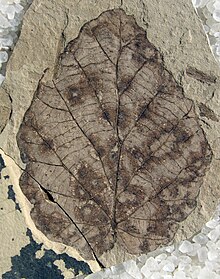Fothergilla malloryi
|
Fothergilla malloryi Temporal range: Ypresian 49.5 Ma |
|
|---|---|
 |
|
| Fothergilla malloryi specimen | |
| Scientific classification | |
| Kingdom: | Plantae |
| Clade: | Angiosperms |
| Clade: | Eudicots |
| Order: | Saxifragales |
| Family: | Hamamelidaceae |
| Genus: | Fothergilla |
| Species: | F. malloryi |
| Binomial name | |
|
Fothergilla malloryi Radtke, Pigg, & Wehr, 2005 |
|
Fothergilla malloryi is an extinct species of flowering plant in the family Hamamelidaceae known from fossil leaves found in the early EoceneKlondike Mountain Formation deposits of Northern Washington State. The F. malloryi leaves are the earliest appearance in the fossil record of a member of the witchalder genus Fothergilla, which includes the living species F. gardenii, and F. major, both of which are native to the southeastern United States. The genus also includes three or four other fossil species with two Asian Miocene species, F. viburnifolia from China, F. ryozenensis from Japan along with one Miocene North American species, F. praeolata of Oregon. Fothergilla durhamensis described from Eocene sediments in King County, Washington is considered dubious in placement.
Fothergilla malloryi is represented by a single counterpart compression fossil specimen from the Ypresian aged Klondike Mountain Formation which outcrops in Republic, Ferry County, Washington. The age of the formation is based on Argon–argon dating, which has returned a date of 49.4 ±0.5 million years old. The fossil was recovered from "Boot Hill", University of Washington site UWBM B4131 located within the city limits of Republic.
...
Wikipedia
